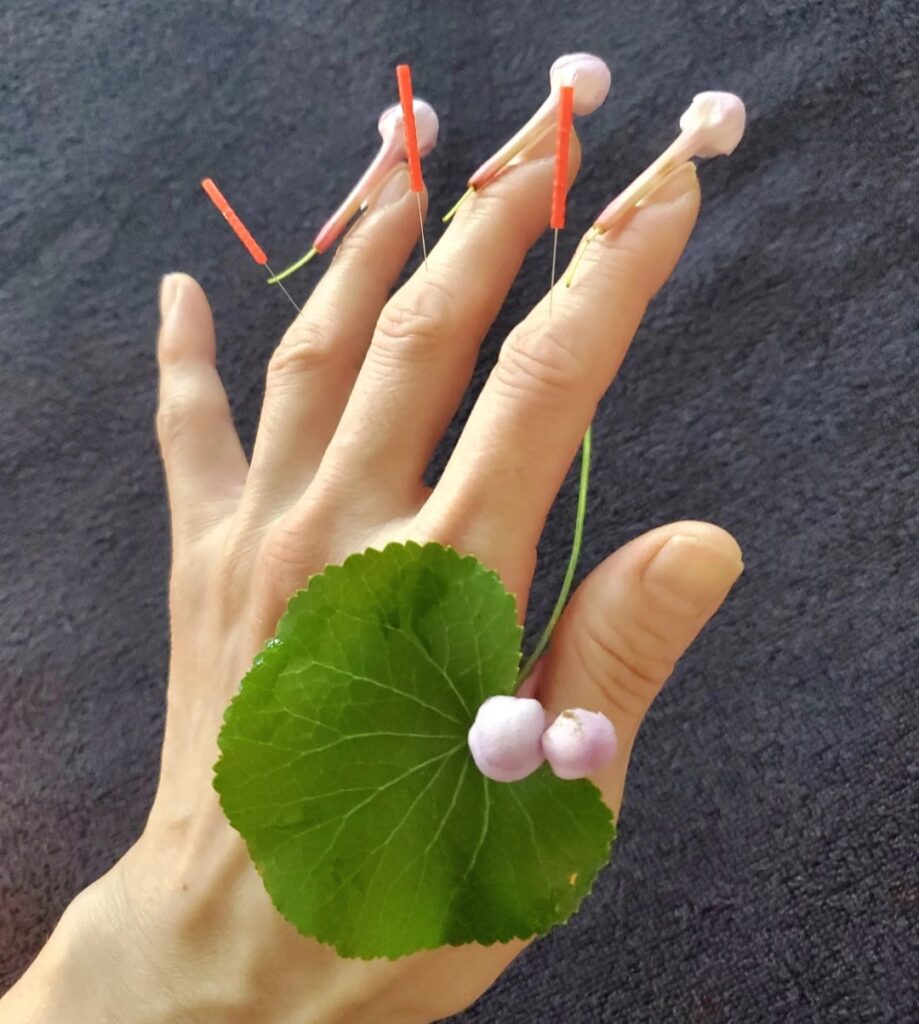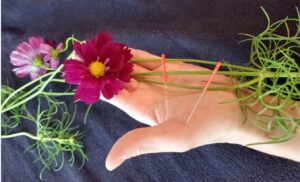変形性指関節症
Osteoarthritis of the fingers
形性指関節症は、指の関節に、腫れや痛み、変形が起こる病気です。関節リウマチでも指の変形は起こりますが、関節リウマチは全身の病気のため、ひざ、手首など、指以外の関節にも変形が現れますが、変形性指関節症は、指だけに起こり、しかも特定の関節に起こります。指の骨の関節には、他の体の関節と同様、骨同士の衝突を防ぐためにクッションの役割を果たす軟骨があります。しかし、この軟骨がすり減って骨同士が摩擦を繰り返すことで炎症が起こり、腫れや痛み、変形を生じます。40歳以降の女性に多く、高齢になるほど発症率は高くなります。理由としては女性ホルモンの一つであるエストロゲン(卵胞ホルモン)には、手の腱のまわりを包んでいる部分(腱鞘)や、関節の内側をおおう膜(滑膜)に水がたまったり、むくんだりするのを抑制する作用がありますが、そのエストロゲン分泌量は40歳以降に、急激に低下します。それが、腱鞘炎を起こしたり関節が破壊されたりする原因にもなります。また、手仕事を長年続けてきた人にも発症が多いです。外傷性では突き指などのけがの後遺症で、その指だけに起こる場合もあります。変形が始まると個人差がありますが、4~5年で変形が目立つようになり、ほとんどの場合すべての指に変形がでます。変形の進行を止めることは困難と言われています。関節が伸びなくなるのとは別に横に曲がってくることがあり、外観的にもストレスとなることがあります。変形は、親指の付け根にある「母指CM関節」や、指の第一関節・第二関節に発症しやすく、第一関節に生じたものは「ヘバーデン結節」、第二関節に生じたものは「ブシャール結節」と呼ばれています。ヘバーデン結節は別名「指曲がり症」とも呼ばれ、指が曲がったまま伸びなくなり、痛みや可動域制限で日常生活に大きく支障をきたすこともあります。関節の背側に二つのコブ(結節)ができるのが特徴で、膝に水がたまるのと同じ様に、爪との間に水膨れ(粘液嚢腫)ができることがあります。この段階になると、強い痛みが出ることがあります。放置して治療せずに指を使い続けると、次第に指が変形していきます。やがて骨どうしがくっつき、そのまま固定してしまうと、炎症は治まって腫れや痛みはなくなりますが、指は変形したまま、動きづらくなります。発症から指が変形して固定するまでにかかる期間には個人差があります。1~2年間や、もっと長い年数をかけてゆっくりと進行する人もいます。症状としては、指を動かさすと痛む、可動域が狭まる、見た目からわかるくらい指が変形してしまうなどが挙げられます。痛みの強さや変形には個人差がありますが、物を持つこともままならなくなる場合もあります。
近年、大豆イソフラボンと腸内細菌によって作られるエクオールという物質が、エストロゲンと同じ作用をすると注目されていますが、日本人の半分以上はこのエクオールを体内で作ることができません。手指の変形性関節症は、親子間などで遺伝性があるのではないかといわれていますが、それはエクオールを生成できない体質が遺伝している可能性もあります。身内に発症者がいる場合は、予防のためにも早めにサプリメントでエクオール補充しておくのも良いと思います。鍼灸は人間が持つ傷の修復作用を利用しています。人間が体に傷を負うと血液循環が促進されるのですが、鍼灸では鍼やお灸を使い、あえて微細な傷を作り出すことで、血液循環を促し、血行を促進させ、疼痛物質を流し、患部の血流を改善させて、傷んだ筋や腱に栄養を与え、症状の回復をしていきます。
Osteoarthritis of the fingers is a disease that causes swelling, pain, and deformity of the joints of the fingers. Rheumatoid arthritis also causes finger deformities, but because rheumatoid arthritis is a systemic disease, deformities also appear in joints other than the fingers, such as the knees and wrists, while osteoarthritis occurs only in the fingers and in specific joints. Like other joints in the body, the joints of the finger bones have cartilage that acts as a cushion to prevent bones from colliding with each other. It is more common in women after the age of 40, and the incidence increases with age. The reason for this is that estrogen (follicle hormone), one of the female hormones, has the effect of reducing water retention and swelling in the sheath that surrounds the tendons of the hand and in the synovial membrane that covers the inside of the joints, Estrogen secretion declines sharply after the age of 40. This can lead to tendonitis and joint destruction. It is also common in people who have been doing manual labor for many years. In traumatic cases, it may occur only in that finger as an aftereffect of an injury such as a jamming finger. Once the deformity begins, it may take 4 to 5 years for the deformity to become noticeable, although it varies from person to person, and in most cases all fingers are deformed. It is said that it is difficult to stop the progression of deformity. Apart from the loss of joint elongation, the joints may also bend sideways, which can be cosmetically stressful. Deformities tend to develop at the "thumb CM joint" at the base of the thumb and at the first and second joints of the fingers, with those at the first joint being called "Heberden's nodes" and those at the second joint being called "Bouchard's nodes. Heberden's nodes, also known as "crooked finger syndrome," cause the fingers to remain bent and unable to extend, and pain and limited range of motion can greatly interfere with daily life. It is characterized by the formation of two bumps (nodules) on the dorsal surface of the joint, and a bulge (myxocele) may form between the nodule and the nail, similar to the formation of water in the knee. At this stage, severe pain may occur. If the finger is left untreated and used continuously, the finger will gradually become deformed. When the bones eventually attach to each other and are fixed in place, the inflammation subsides and the swelling and pain disappear, but the finger remains deformed and is difficult to move. The time it takes from the onset of the disease until the finger becomes deformed and fixed varies from person to person; some patients may have the disease for one to two years, while others may have it for much longer, progressing more slowly. Symptoms include pain when the finger is moved, a narrowed range of motion, and a visually noticeable deformation of the finger. The intensity of the pain and deformity varies from person to person, but in some cases, the patient may not even be able to hold things.
Recently, a substance called Equol, which is produced by soy isoflavones and intestinal bacteria, has been attracting attention for having the same effect as estrogen, but more than half of Japanese people cannot produce Equol in their bodies. Osteoarthritis of the fingers is said to be hereditary between parents and children, but it is also possible that the constitution that is unable to produce Equol is inherited. If you have a family member who has the disease, it is a good idea to supplement with Equol as early as possible to prevent it. Acupuncture uses the human body's ability to repair wounds. When a human body is injured, blood circulation is stimulated. Acupuncture and moxibustion use needles and moxibustion to create microscopic wounds on a dare to stimulate blood circulation, stimulate blood circulation, flush out pain substances, improve blood flow to the affected area, nourish injured muscles and tendons, and recover from symptoms.

#fingerpain #rhumatoidarthritis #指痛い #リウマチ #指 #突き指 #jammedfinger


